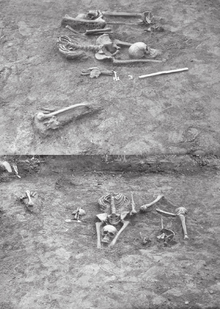Vampire burial
A vampire burial or anti-vampire burial is a burial performed in a way which was believed to prevent the deceased from revenance in the form of a vampire or to prevent an "actual" vampire from revenance. Traditions, known from the medieval times, varied.[1][2][3]

An example of anti-vampire burial in Poland
By an association, the term "vampire burial" may also refer to burials apparently performed with rituals associated with beliefs that the buried may arise from the dead or evil spirits may come out of the grave, etc., and these rituals were intended to prevent this from happening. An example of this is believed to be the case of mid-5th century "Children's Necropolis" of Lugnano in Teverina, Italy.[4]
Archeologists uncovered a number of burials believed to be of this type.
- A mid-16th century burial of a woman on the island of Lazzaretto Nuovo in the Venice lagoon, Italy,[3]
- Some interments in a cemetery in Greater Poland, dated 1675-1880.[5]
- Drawsko cemetery, Poland, dated to 17th-18th centuries[6] However the theory about "vampire burials" there has been contested later.[7]
- Gliwice, Poland, undated[8]
- Medieval cemetery site in Kałdus, Poland[9]
- Anti-vampire burial from Sanok
References
- "How to Properly Bury a Vampire", Live Science, June 7, 2012
- "'Vampire' Graves Uncovered in Poland", Live Science, July 12, 2013
- ""Vampire" unearthed in Venice plague grave", Reuters, MARCH 12, 2009
- "'Vampire Burial' Reveals Efforts to Prevent Child's Return from Grave"
- "The Vampires of Wielkopolska"
- "Mystery of 'Vampire' Burials Solved", Live Science, November 26, 2014
- "Poland’s Sickle-Wearing Corpses Not Vampire Burials", history.com, December 22, 2015
- "Polish archaeologists unearth 'vampire grave'", The Telegraph, July 11, 2013
- "Healthy 'Vampires' Emerge From Graves In Medieval Polish Cemetery", Forbes, June 1, 2016
This article is issued from Wikipedia. The text is licensed under Creative Commons - Attribution - Sharealike. Additional terms may apply for the media files.